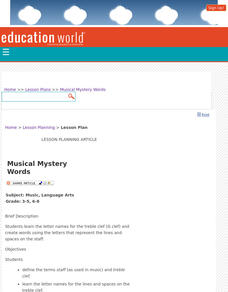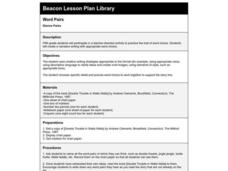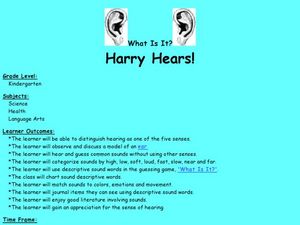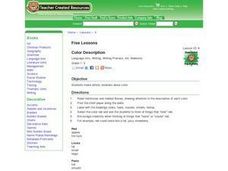Curated OER
Responding Syllables: Reading and Music
Shell Silverstein’s “Sick” provides an opportunity for kids to demonstrate their understanding of syllables and phonemes. The class creates a list of descriptive words used in the poem that have more than one syllable, and brainstorm how...
Curated OER
Musical Mystery Words
Students study the letter names for the treble clef and create words using the letters that represent the lines and spaces on the staff.
Curated OER
Texture Tiles
Students explore teh use of texture. After compiling a list of descriptive words for various textures, students use modeling clay and tools to create a tile to demonstrate one of the textures from their list.
Curated OER
Word Pairs
Fifth graders practice the trait of word choice and create a narrative writing with appropriate word choices. They work in pairs to write a story using as many word pairs from their imaginations as they can.
Roald Dahl
Matilda - Miss Honey and The Trunchbull
As the instructor reads aloud several quotes from five chapters of the story Matilda, class members mime their interpretation of the scenes. Then, after reading "Miss Honey" and "The Trenchbull" (chapters seven and eight), the...
Curated OER
Little Engine That Could Lesson Plan
Students retell the story The Little Engine That Could by Watty Piper. In this early childhood lesson plan, students identify the various trains featured in the story, focusing on the descriptive words. Students then create their own...
Curated OER
Create a Word Graveyard to Teach Synonyms
Young scholars explore descriptive writing by creating headstones. In this memorial lesson, students utilize an 11" x 17" piece of paper to create a cemetery headstone memorializing a word rather than a person. Young scholars decorate...
Curated OER
Poetry as a Fine Art
Sixth graders use a visit to the National Gallery of Art to inspire descriptive writing. They choose works of art and write descriptive word lists, paragraphs and Haiku.
Curated OER
Color Descriptions
Students create a book about colors. In this exploring colors lesson, students read the book Hailstones and Halibut Bones. Students select a color and describe how the color looks, feels, tastes, and smells like. Students write down...
Curated OER
Superhero Comic Strip Using Greek and Latin Roots
Students create comic strips in groups and explain to the class the Latin and Greek roots of their superhero names. In this Latin and Greek root lesson plan, students get into groups and come up with superhero characters to integrate...
Ogden Museum of Art Education Department
Literacy and Landscapes
As the saying goes, art often imitates life ... and literature! A series of activities designed to accompany a visit to the Ogden Museum of Southern Art encourage writers to find inspiration in various landscapes. The lesson includes a...
Curated OER
Harry Hears!
Students explore ear anatomy and the sense of hearing. In this hearing lesson, students discuss the five senses and view a model of an ear. Students place cotton balls in their ears to simulate loss of hearing. Students use descriptive...
Curated OER
Dream Bed
Learners design and write descriptions of imaginary beds. In this interior design lesson, students use various art materials such as paint, fabric, boxes, and string to create a model of a bed. Learners use descriptive words to write a...
Curated OER
State or Region Project
Invite your youngsters to learn about a state or region through their choice of a creative project. The resource lists 15 project options that range from a 3-D map of the area, to a puppet show about the region. Pupils can also propose...
Curated OER
Friendly Idea Webs
Students examine methods of creating an idea web. In groups, they create a coding system that represent various categories and then design an idea web about one person in the group by listing words that describe the person. Students...
Curated OER
Adjective Monster
Explore descriptive writing and visual art. Listen to the story Go Away Big, Green Monster by Ed Emberley and generate a list of adjectives used in the book. Name familiar shapes and create a shapes list. Choose an adjective and shape to...
Curated OER
Descriptive Drawings - Pen and Ink - Art with Text
Students create a pen and ink drawing using words to determine values choosing a work with high emotional content and incorporating words that describe the picture's content placing words together tighter, made bolder, etc. to achieve...
Curated OER
Color Description
Young scholars explore the use of description in literature and color. They read Hailstones and Halibut Bones and discuss the description of each color. Students what each color makes them think of and they create pictures for each color.
Curated OER
Image to Word
Students research art and write about how a certain art piece relates to their own life. In this art lesson plan, students go to Brooks museum and discuss the art they find there.
Curated OER
Spring into Poetry
How many different types of poetry are there? Let me count them; list poems, haiku, and makes-me-think poems are only a few. Learners create their own poems accompanied by artistic projects such as haiku poems written on kites.
Curated OER
Skippyjon Jones Lesson Plan
Students meet an imaginative Siamese kitten pretends to be a Chihuahua when he is in time-out. In this Skippyjon Jones lesson plan, students develop an understanding of different cultures. They understand different dialects and...
Curated OER
And Now, A Word From Our Sponsor
Students act as groups of event planners to invent large entertainment events, determine appropriate sponsorship categories for them, identify potential sponsors within those categories, and pitch their ideas to those companies.
Curated OER
Animal Action
Students construct descriptive sentences. For this cross curricular music and descriptive writing lesson, students listen to classical music and pantomime actions that correspond to the music. Students write descriptive sentences...
Curated OER
Creating Characters: Movement
Students compare two characters and role-play how they would perform various actions. They view and discuss a video, list opposite descriptions for the two girls in the video, and role-play the opposites.























